A 7–13 GHz 10 W High-Efficiency MMIC Power Amplifier in 0.25 µm GaN HEMT Process
Abstract
:1. Introduction
2. The 0.25 μm GaN/SiCProcess
3. Circuit Design
3.1. Power Amplifier Structure
3.2. Stability Analysis and Design
3.3. Broadband Design Consideration
3.4. Design of Output Matching Network (OMN)
- (1)
- Achieve conjugate matching and attain the maximum PAE while maintaining a relatively high power;
- (2)
- The power transmitted by the microstrip line and the components cannot exceed its power tolerance;
- (3)
- Network matching should be as simple as possible to reduce losses;
- (4)
- The standing wave coefficient of the output terminal should not be too large, which is convenient for interconnection with external systems;
- (5)
- The design of the DC feeding network is reasonable.
3.5. Design of Inter-Stage and Input Matching Network
4. Power Amplifier Measurement Results
5. Conclusions
Author Contributions
Funding
Institutional Review Board Statement
Informed Consent Statement
Data Availability Statement
Conflicts of Interest
References
- Oreja-Gigorro, E.; Delgado Pascual, E.; Sanchez-Martinez, J.J.; Gil-Heras, M.L.; Bueno-Fernandez, V.; Bodalo-Marquez, A.; Grajal, J. A 6–18 GHz GaN on SiC High Power Amplifier MMIC for Electronic Warfare. In Proceedings of the 2018 13th European Microwave Integrated Circuits Conference (EuMIC), Madrid, Spain, 23–25 September 2018; pp. 85–88. [Google Scholar] [CrossRef]
- Couturier, A.M.; Poitrenaud, N.; Serru, V.; Dionisio, R.; Fontecavc, J.J.; Camiade, M. 50% High Efficiency X-Band GaN MMIC Amplifier for Space Applications. In Proceedings of the 2018 48th European Microwave Conference (EuMC), Madrid, Spain, 23–27 September 2018; pp. 352–355. [Google Scholar] [CrossRef]
- Ye, W.; Ma, K.; Yeo, K.S. 2.5 A 2-to-6 GHz Class-AB power amplifier with 28.4% PAE in 65 nm CMOS supporting 256 QAM. In Proceedings of the 2015 IEEE International Solid-State Circuits Conference—(ISSCC) Digest of Technical Papers, San Francisco, CA, USA, 22–26 February 2015; pp. 1–3. [Google Scholar] [CrossRef]
- Ezzeddine, B.A.; Hung, H.A.; Viveiros, E.; Huang, H.-C. High-power GaN MMIC PA Over 40–4000MHz. In Proceedings of the 2013 IEEE MTT-S International Microwave Symposium Digest (MTT), Seattle, WA, USA, 2–7 June 2013; pp. 1–4. [Google Scholar] [CrossRef]
- Schellenberg, J.M. A 2-W W-Band GaN Traveling-Wave Amplifier With 25-GHz Bandwidth. IEEE Trans. Microw. Theory Tech. 2015, 63, 2833–2840. [Google Scholar] [CrossRef]
- Campbell, C.F.; Nayak, S.; Ming-Yih, K.; Chen, S. Design and performance of 16–40 GHz GaN distributed power amplifier MMICs utilizing an advanced 0.15 µm GaN process. In Proceedings of the 2016 IEEE MTT-S International Microwave Symposium (IMS), San Francisco, CA, USA, 22–27 May 2016; pp. 1–4. [Google Scholar] [CrossRef]
- Kim, Y.; Kwon, Y. Analysis and Design of Millimeter-Wave Power Amplifier Using Stacked-FET Structure. IEEE Trans. Microw. Theory Tech. 2015, 63, 691–702. [Google Scholar] [CrossRef]
- Hu, L.; Liao, X.; Zhang, F.; Wu, H.; Ma, S.; Lin, Q.; Tang, X. A Wideband High-Efficiency GaN MMIC Power Amplifier for Sub-6-GHz Applications. Micromachines 2022, 13, 793. [Google Scholar] [CrossRef] [PubMed]
- Gustafsson, D.; Cahuana, J.C.; Kuylenstierna, D.; Angelov, I.; Rorsman, N.; Fager, C. A Wideband and Compact GaN MMIC Doherty Amplifier for Microwave Link Applications. IEEE Trans. Microw. Theory Tech. 2013, 61, 922–930. [Google Scholar] [CrossRef]
- Meghdadi, M.; Medi, A. Design of 6–18-GHz High-Power Amplifier in GaAs pHEMT Technology. IEEE Trans. Microw. Theory Tech. 2017, 65, 2353–2360. [Google Scholar] [CrossRef]
- Khan, A.; Sarbishaei, H.; Boumaiza, S. High efficiency two-stage GaN power amplifier with improved linearity. In Proceedings of the 2014 IEEE Topical Conference on Power Amplifiers for Wireless and Radio Applications (PAWR), Newport Beach, CA, USA, 19–23 January 2014; pp. 4–6. [Google Scholar]
- Zhuang, Y.; Zhou, J.; Huang, Y.; Chen, A. Design of a broadband high efficiency GaN power amplifier for GNSS applications. In Proceedings of the 2016 IEEE MTT-S International Wireless Symposium (IWS), Shanghai, China, 14–16 March 2016; pp. 1–4. [Google Scholar]
- Lin, Q.; Wu, H.-F.; Hua, Y.-N.; Chen, Y.-J.; Hu, L.-L.; Liu, L.-S.; Chen, S.-J. A 2–20-GHz 10-W High-Efficiency GaN Power Amplifier Using Reactive Matching Technique. IEEE Trans. Microw. Theory Tech. 2020, 68, 3148–3158. [Google Scholar] [CrossRef]
- Campbell, C.F.; Balistreri, A.; Kao, M.-Y.; Dumka, D.C.; Hitt, J. GaN Takes the Lead. IEEE Microw. Mag. 2012, 13, 44–53. [Google Scholar] [CrossRef]
- Pengelly, R.S.; Wood, S.M.; Milligan, J.W.; Sheppard, S.T.; Pribble, W.L. A Review of GaN on SiC High Electron-Mobility Power Transistors and MMICs. IEEE Trans. Microw. Theory Tech. 2012, 60, 1764–1783. [Google Scholar] [CrossRef]
- X-Band 10 W MMIC High-Gain Power Amplifier with up to 60% PAE. Available online: https://www.zhangqiaokeyan.com/open-access_resources_thesis/0100060693390.html (accessed on 6 October 2022).
- Van Heijningen, M.; de Hek, P.; Dourlens, C.; Fellon, P.; Adamiuk, G.; Ayllon, N.; van Vliet, F. C-Band Single-Chip Radar Front-End in AlGaN/GaN Technology. IEEE Trans. Microw. Theory Tech. 2017, 65, 4428–4437. [Google Scholar] [CrossRef]
- Liu, R.-J.; Zhu, X.-W.; Xia, J.; Chen, P.; Yu, C.; Wu, X.-L.; Chen, X. Highly Efficient Wideband GaN MMIC Doherty Power Amplifier Considering the Output Capacitor Influence of the Peaking Transistor in Class-C Operation. IEEE Trans. Circuits Syst. Regul. Pap. 2022, 69, 1932–1942. [Google Scholar] [CrossRef]
- Aust, M.V.; Sharma, A.K.; Fordham, O.; Grundbacher, R.; To, R.; Tsai, R.S.; Lai, R. A 2.8-W Q-Band High-Efficiency Power Amplifier. IEEE J. Solid-State Circuits 2006, 41, 2241–2247. [Google Scholar] [CrossRef]
- Ayad, M.; Poitrenaud, N.; Serru, V.; Camiade, M.; Gruenenpuett, J.; Riepe, K.J. A High Efficiency MMIC X-band GaN Power Amplifier. In Proceedings of the 2020 50th European Microwave Conference (EuMC), Utrecht, The Netherlands, 12–14 January 2021; pp. 788–791. [Google Scholar] [CrossRef]
- Tao, H.-Q.; Hong, W.; Zhang, B.; Yu, X.-M. A Compact 60W X-Band GaN HEMT Power Amplifier MMIC. IEEE Microw. Wirel. Compon. Lett. 2017, 27, 73–75. [Google Scholar] [CrossRef]
- Shin, D.-H.; Yom, I.-B.; Kim, D.-W. X-band GaN MMIC power amplifier for the SSPA of a SAR system. In Proceedings of the 2017 IEEE International Symposium on Radio-Frequency Integration Technology (RFIT), Seoul, Korea, 30 August–1 September 2017; pp. 93–95. [Google Scholar]
- Van Raay, F.; Quay, R.; Kiefer, R.; Benkhelifa, F.; Raynor, B.; Pletschen, W.; Kuri, M.; Massler, H.; Muller, S.; Dammann, M.; et al. A coplanar X-band AlGaN/GaN power amplifier MMIC on s.i. SiC substrate. IEEE Microw. Wirel. Compon. Lett. 2005, 15, 460–462. [Google Scholar] [CrossRef]
- Dani, A.; Coffey, M.; Popovié, Z. 4W X-band high efficiency MMIC PA with output harmonic injection. In Proceedings of the 2014 9th European Microwave Integrated Circuit Conference, Rome, Italy, 6–7 October 2014; pp. 389–392. [Google Scholar] [CrossRef]
- Schafer, S.; Coffey, M.; Popović, Z. X-band wireless power transfer with two-stage high-efficiency GaN PA/ rectifier. In Proceedings of the 2015 IEEE Wireless Power Transfer Conference (WPTC), Boulder, CO, USA, 13–15 May 2015; pp. 1–3. [Google Scholar] [CrossRef]
- Torii, T.; Imai, S.; Maehara, H.; Miyashita, M.; Kunii, T.; Morimoto, T.; Inoue, A.; Ohta, A.; Katayama, H.; Yunoue, N.; et al. 60% PAE, 30 W X-band and 33% PAE, 100 W Ku-band PAs utilizing 0.15 μm GaN HEMT technology. In Proceedings of the 2016 46th European Microwave Conference (EuMC), London, UK, 4–6 October 2016; pp. 568–571. [Google Scholar] [CrossRef]
- Kang, J.; Moon, J.-S. Highly efficient wideband X-band MMIC class-F power amplifier with cascode FP GaN HEMT. Electron. Lett. 2017, 53, 1207–1209. [Google Scholar] [CrossRef]
- Nikandish, G.; Medi, A. A Design Procedure for High-Efficiency and Compact-Size 5–10-W MMIC Power Amplifiers in GaAs pHEMT Technology. IEEE Trans. Microw. Theory Tech. 2013, 61, 2922–2933. [Google Scholar] [CrossRef]
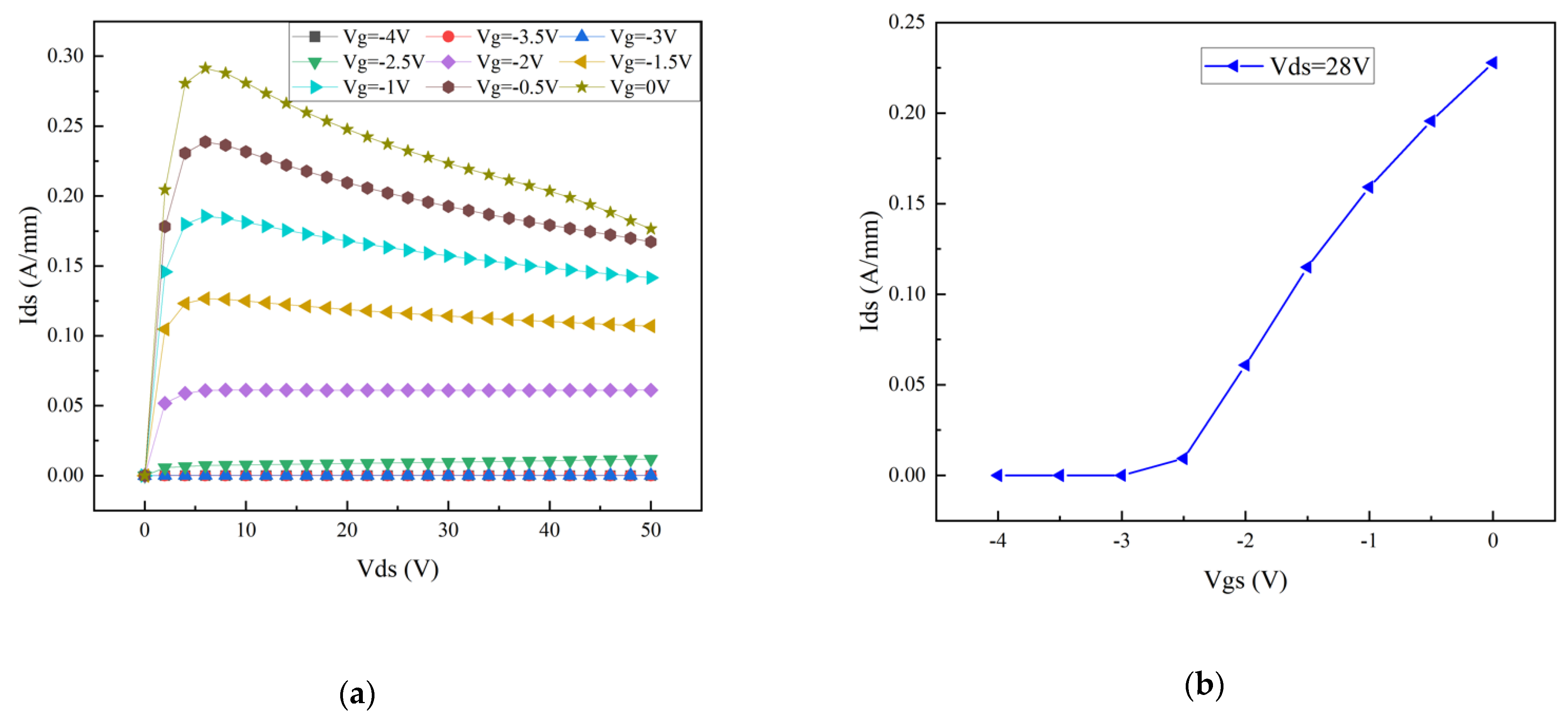
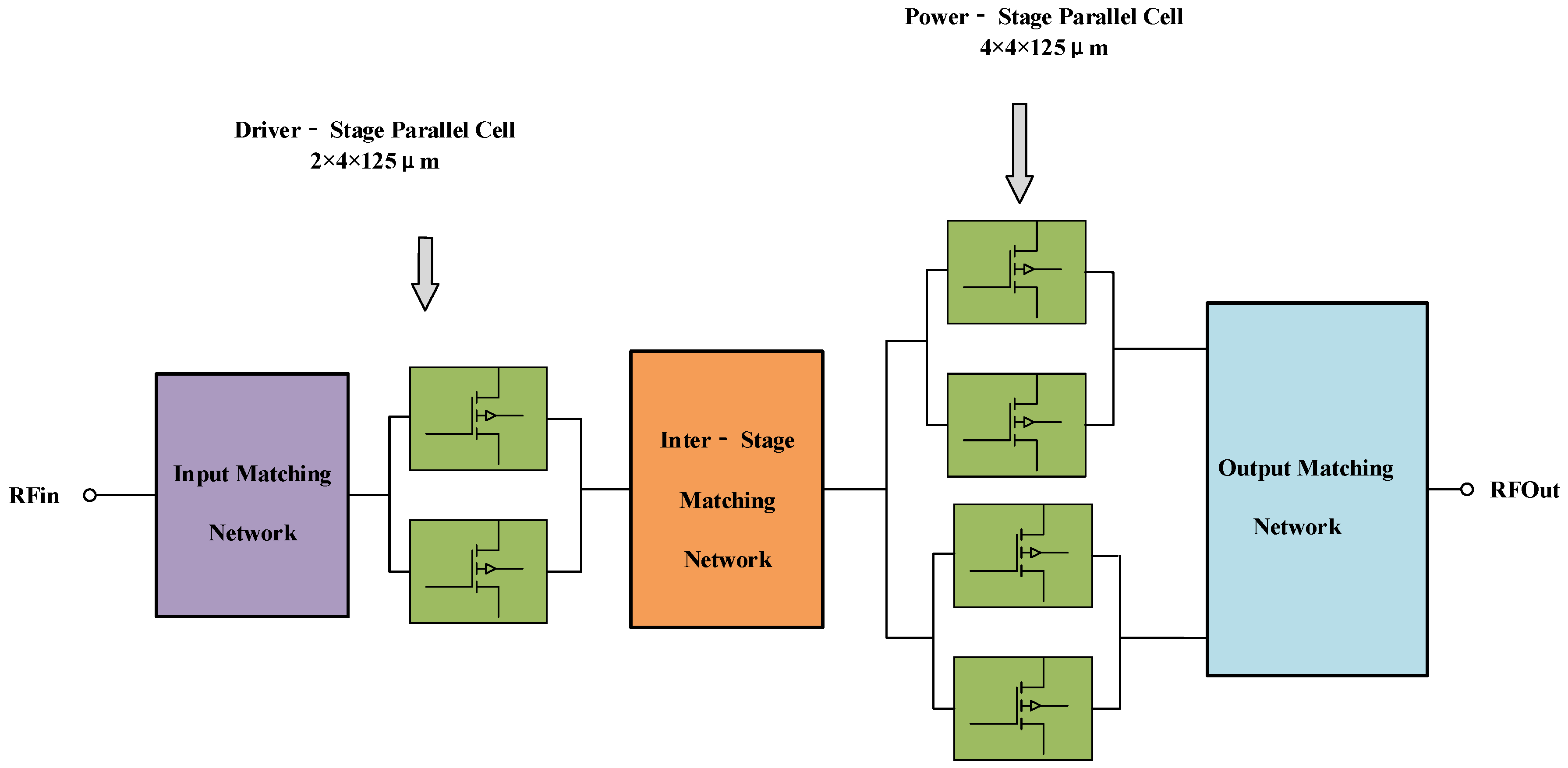
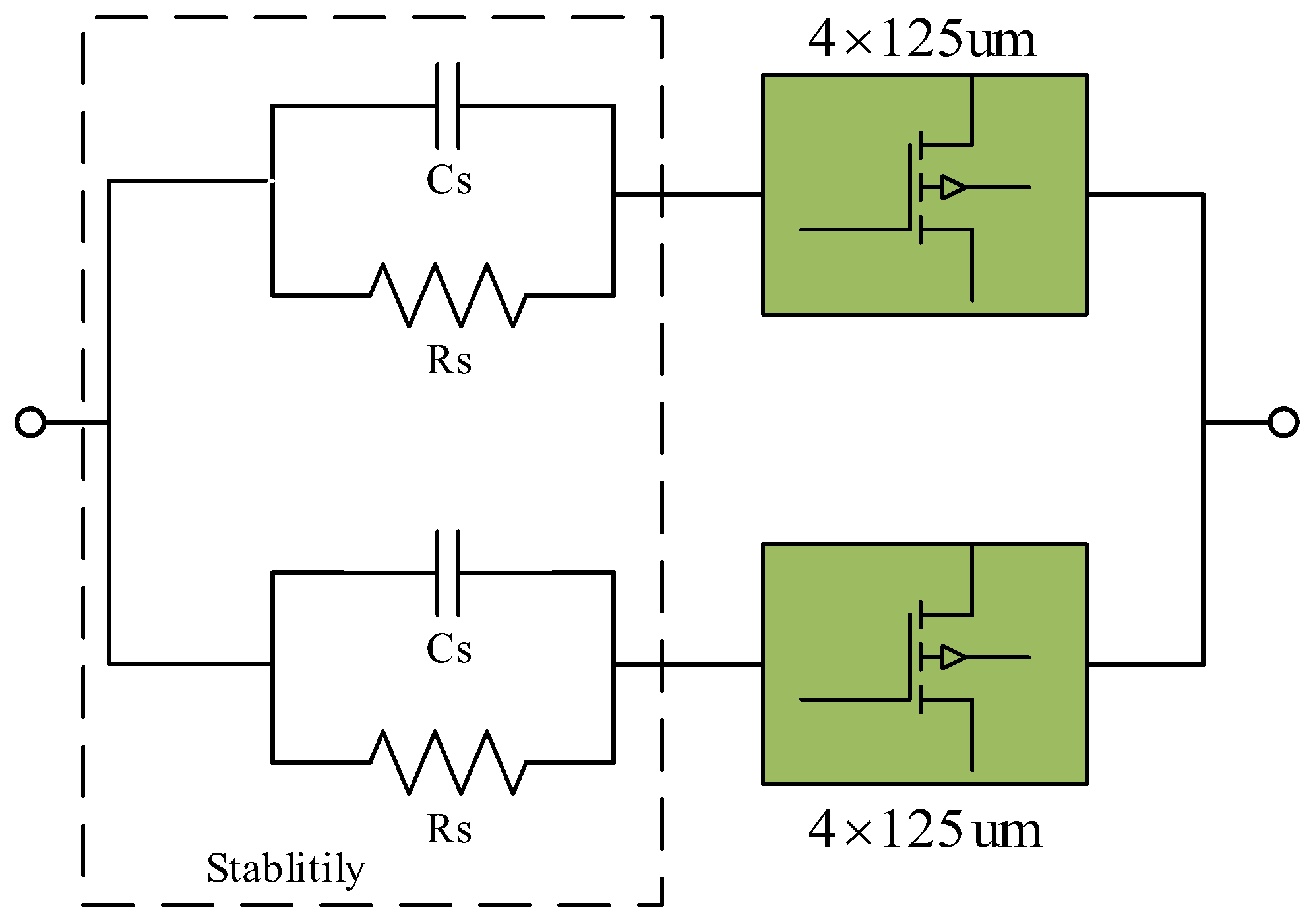
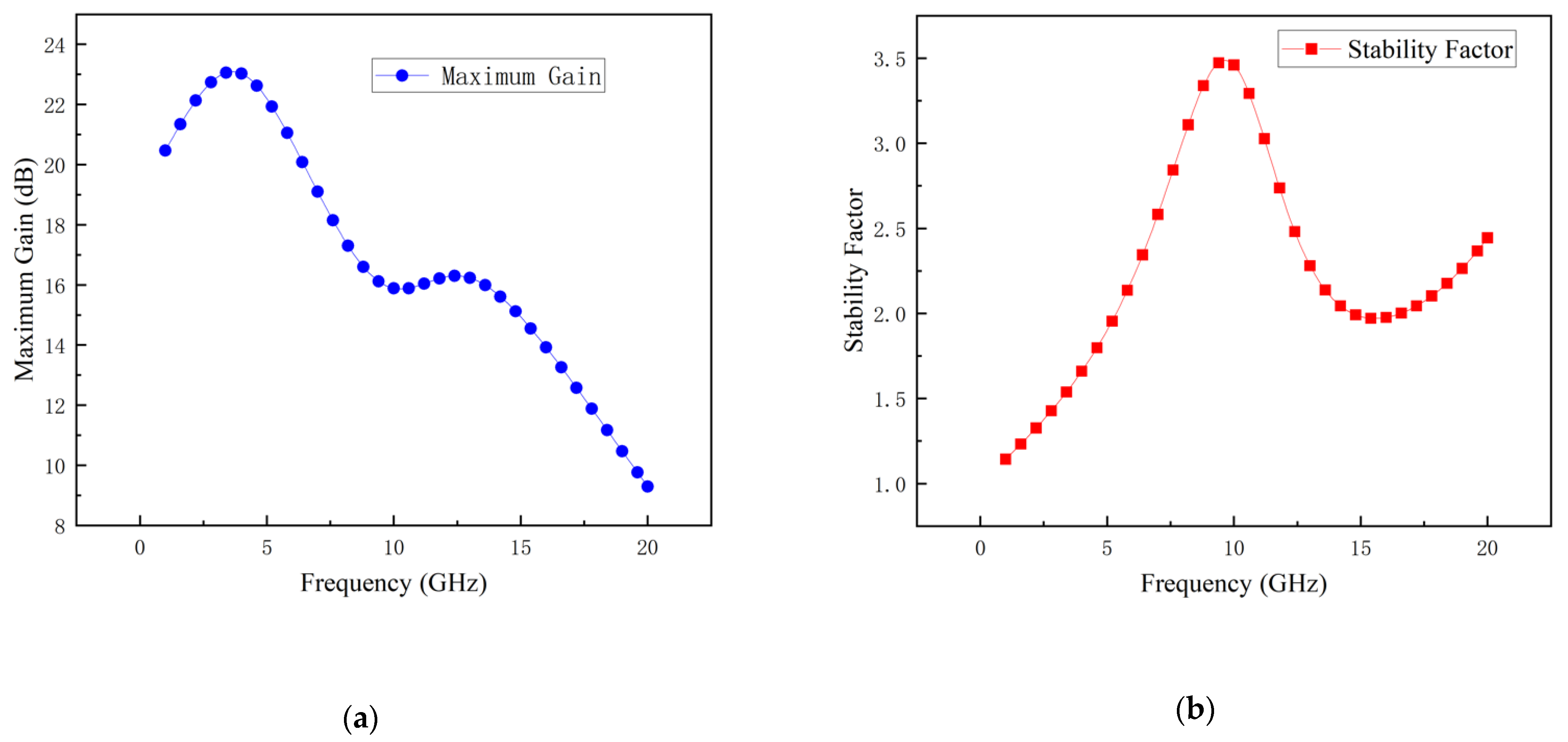


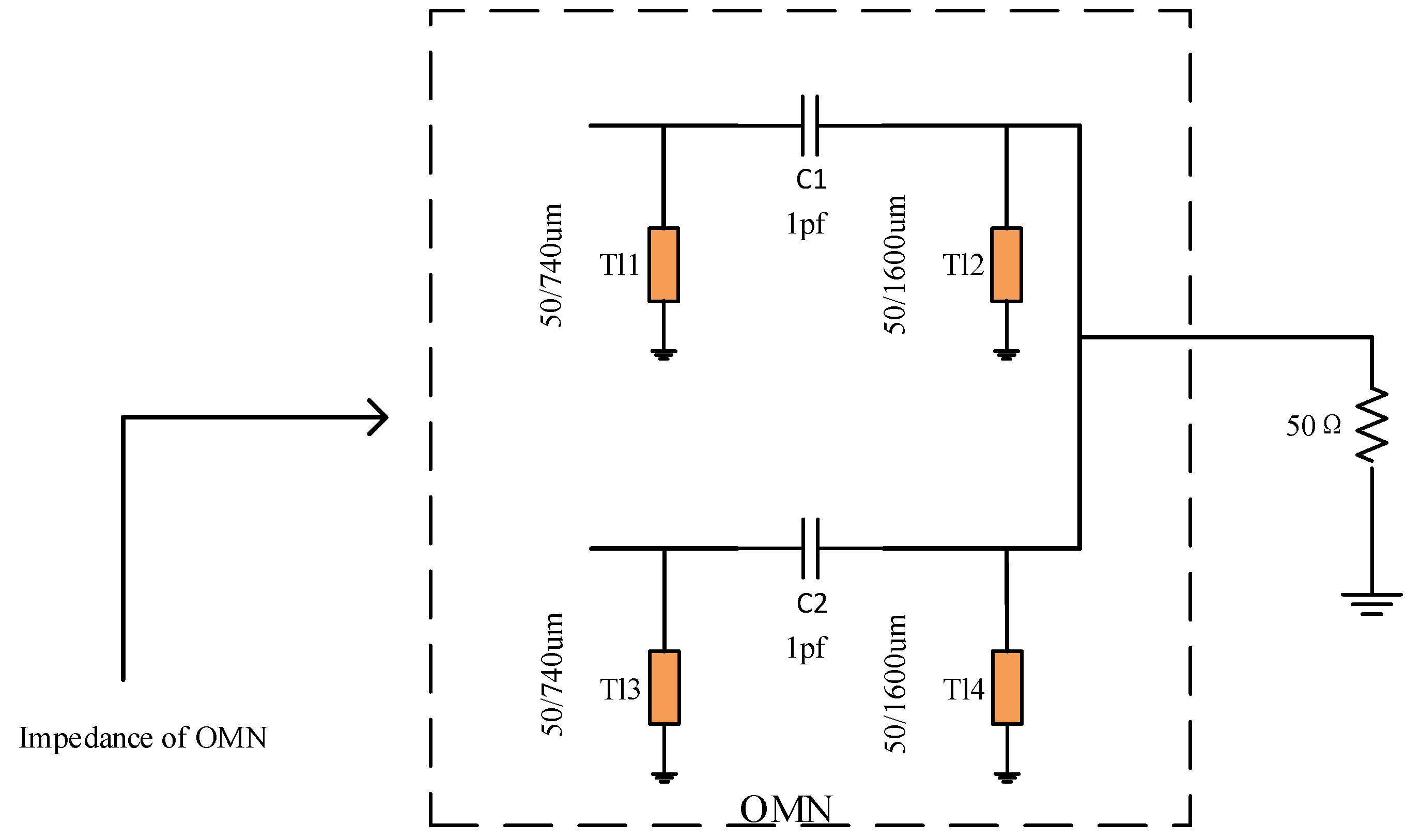
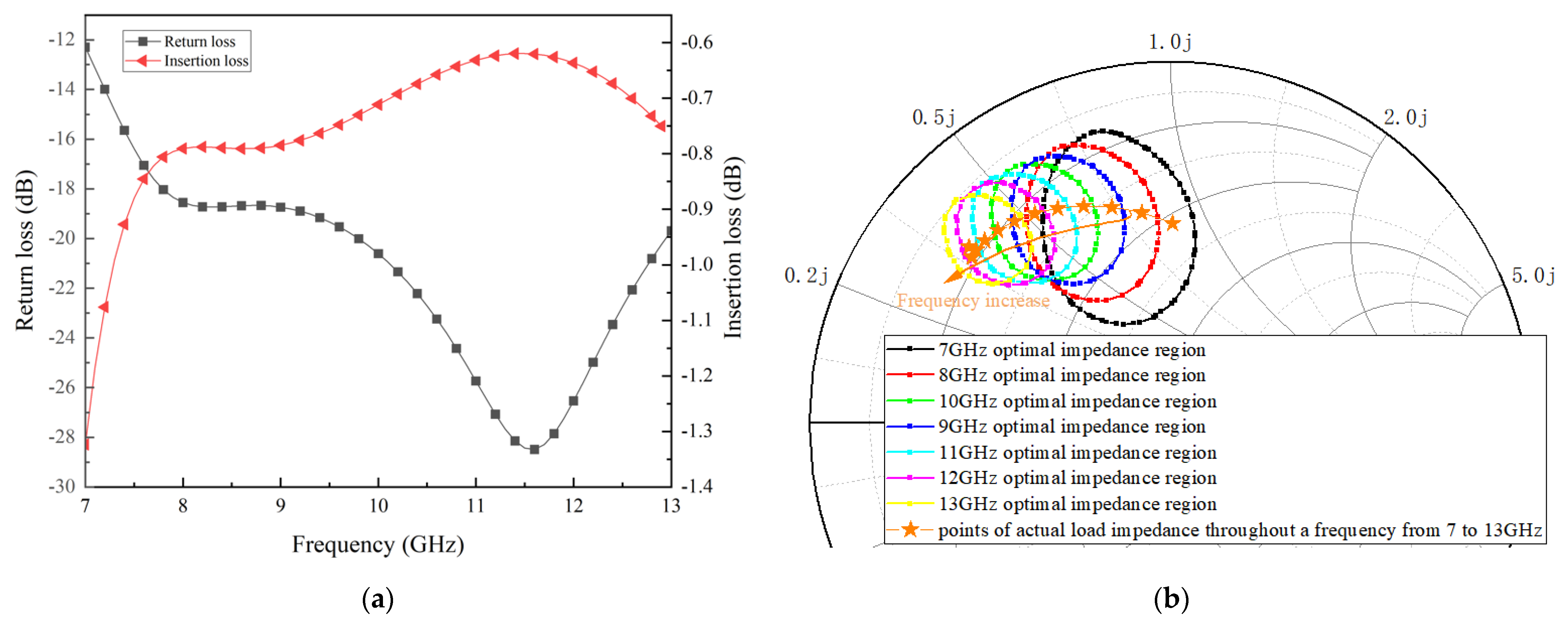

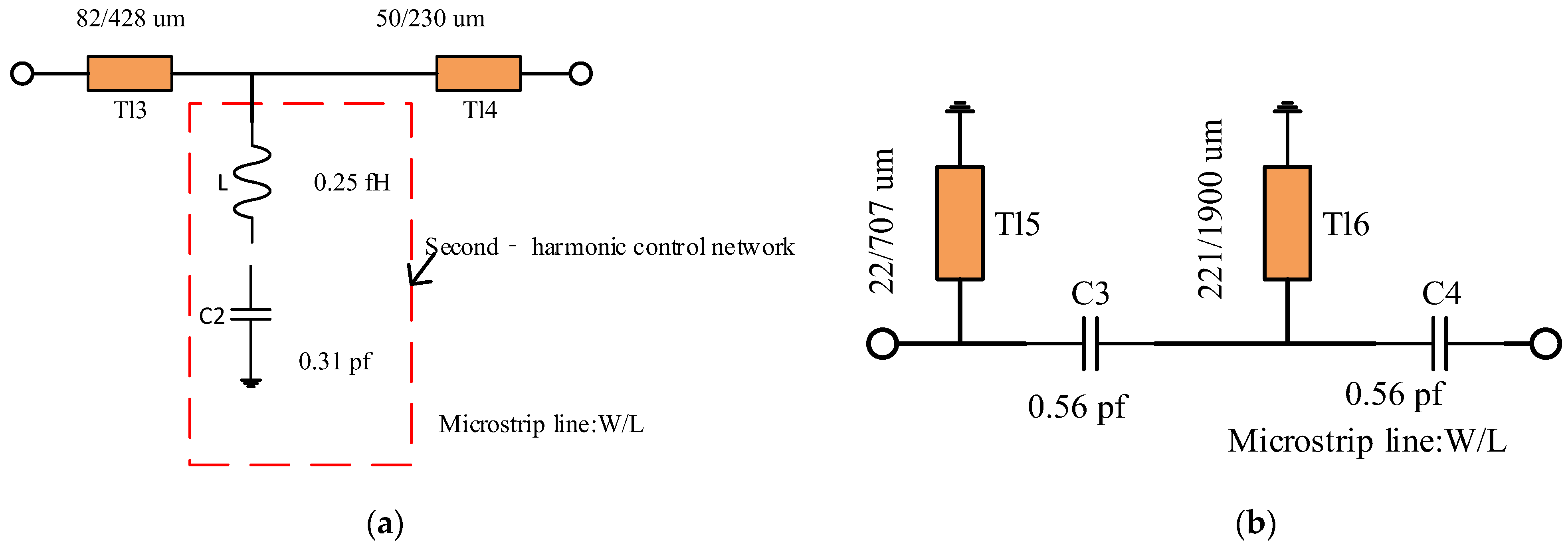
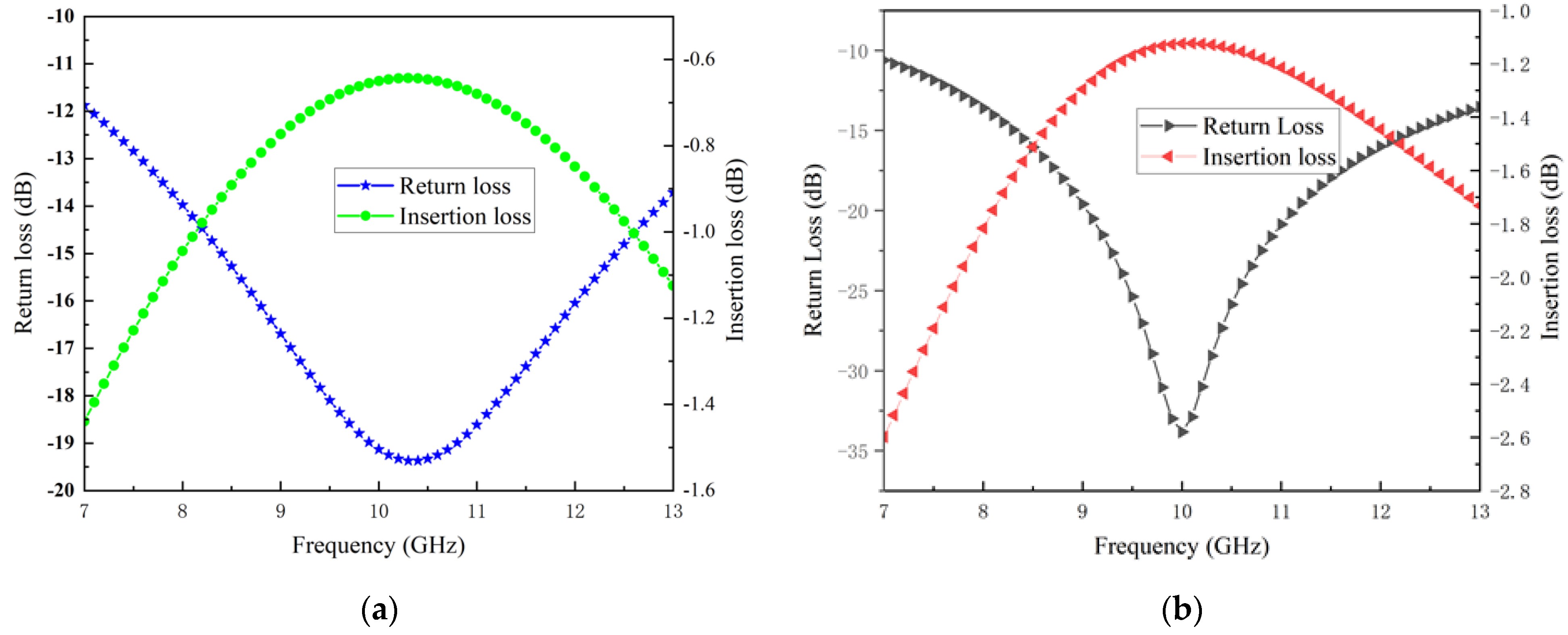
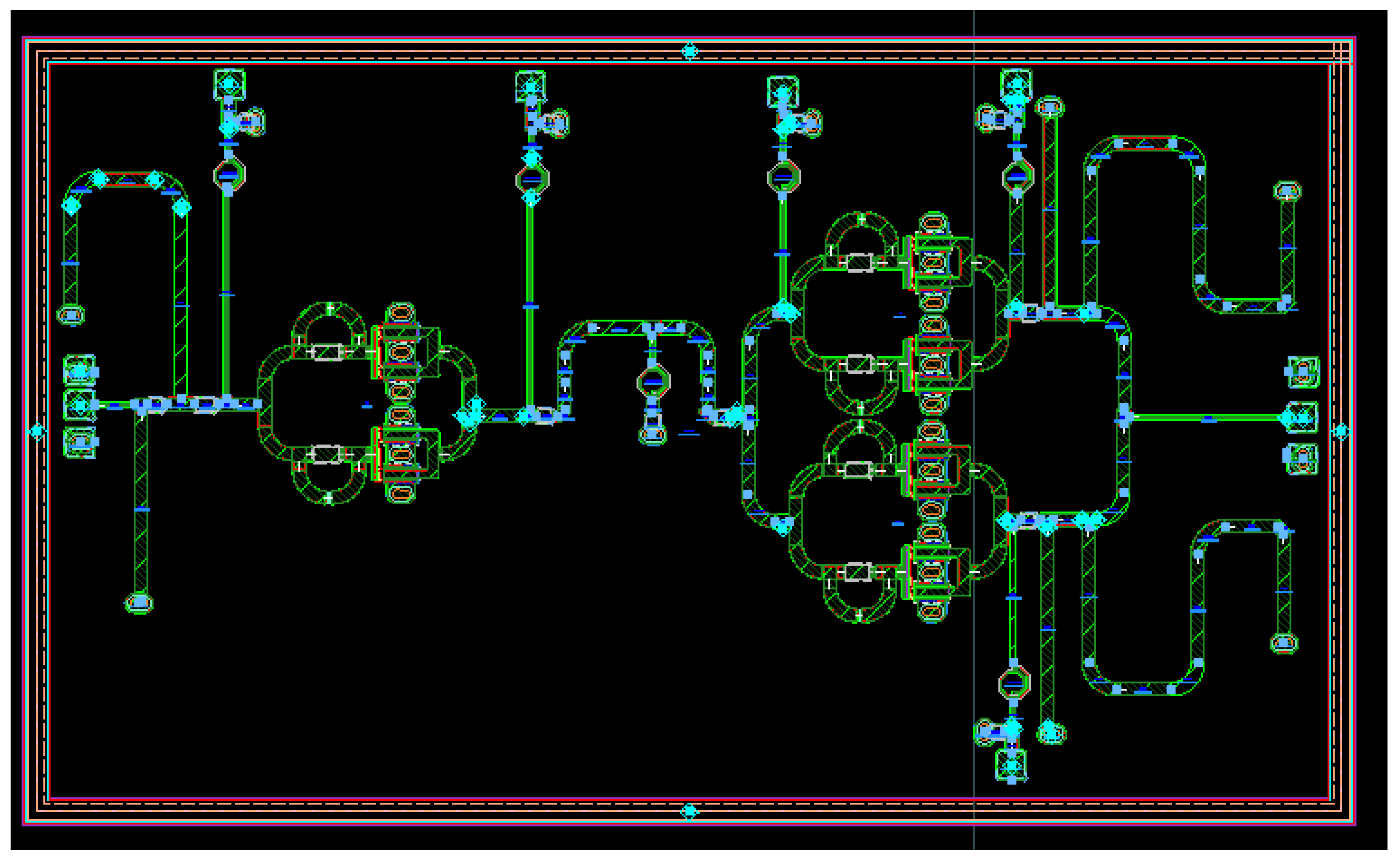

| Parameter | Unit | |
|---|---|---|
| Frequency range | 7–13 | GHz |
| Average | 40 (10) | dBm (W) |
| PAE | 30 | % |
| Power gain | 14 | dB |
| Frequency (GHz) | (dBm) | PAE (%) | |
|---|---|---|---|
| 7 | 8.25 + j18.69 | 39.8 | 59.63 |
| 8 | 17.59 + j31.16 | 37.52 | 57.51 |
| 9 | 6.03 + j16.04 | 38.65 | 57.24 |
| 10 | 11.51 + j22.2 | 37.37 | 57.68 |
| 11 | 3.95 + j13.23 | 38.37 | 56.59 |
| 12 | 4.26 + j11.85 | 37.57 | 55.42 |
| 13 | 9.29 + j20.16 | 37.51 | 54.68 |
Publisher’s Note: MDPI stays neutral with regard to jurisdictional claims in published maps and institutional affiliations. |
© 2022 by the authors. Licensee MDPI, Basel, Switzerland. This article is an open access article distributed under the terms and conditions of the Creative Commons Attribution (CC BY) license (https://creativecommons.org/licenses/by/4.0/).
Share and Cite
Hu, A.; Leng, Y.; Qiu, X.; Luan, T.; Peng, Y. A 7–13 GHz 10 W High-Efficiency MMIC Power Amplifier in 0.25 µm GaN HEMT Process. Appl. Sci. 2022, 12, 10872. https://doi.org/10.3390/app122110872
Hu A, Leng Y, Qiu X, Luan T, Peng Y. A 7–13 GHz 10 W High-Efficiency MMIC Power Amplifier in 0.25 µm GaN HEMT Process. Applied Sciences. 2022; 12(21):10872. https://doi.org/10.3390/app122110872
Chicago/Turabian StyleHu, Aizhen, Yongqing Leng, Xin Qiu, Tongyao Luan, and Yatao Peng. 2022. "A 7–13 GHz 10 W High-Efficiency MMIC Power Amplifier in 0.25 µm GaN HEMT Process" Applied Sciences 12, no. 21: 10872. https://doi.org/10.3390/app122110872
APA StyleHu, A., Leng, Y., Qiu, X., Luan, T., & Peng, Y. (2022). A 7–13 GHz 10 W High-Efficiency MMIC Power Amplifier in 0.25 µm GaN HEMT Process. Applied Sciences, 12(21), 10872. https://doi.org/10.3390/app122110872






